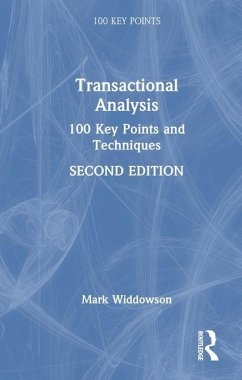Schade – dieser Artikel ist leider ausverkauft. Sobald wir wissen, ob und wann der Artikel wieder verfügbar ist, informieren wir Sie an dieser Stelle.
- Gebundenes Buch
- Merkliste
- Auf die Merkliste
- Bewerten Bewerten
- Teilen
- Produkt teilen
- Produkterinnerung
- Produkterinnerung
- Weitere 6 Ausgaben:
- Gebundenes Buch
- Broschiertes Buch
- Broschiertes Buch
- Broschiertes Buch
- eBook, ePUB
- eBook, PDF
The second edition of Transactional Analysis:100 Key Points and Techniques synthesises developments in Transactional Analysis and psychotherapy research, offering therapists practical guidance on refining TA psychotherapy skills.
Andere Kunden interessierten sich auch für
![Anger, Rage and Relationship Anger, Rage and Relationship]() Sue Parker HallAnger, Rage and Relationship163,99 €
Sue Parker HallAnger, Rage and Relationship163,99 €![Somatic Ego State Therapy for Trauma Healing Somatic Ego State Therapy for Trauma Healing]() Silvia ZanottaSomatic Ego State Therapy for Trauma Healing189,99 €
Silvia ZanottaSomatic Ego State Therapy for Trauma Healing189,99 €![A Therapist's Handbook to Dissolve Shame and Defense A Therapist's Handbook to Dissolve Shame and Defense]() Susan Warren WarshowA Therapist's Handbook to Dissolve Shame and Defense187,99 €
Susan Warren WarshowA Therapist's Handbook to Dissolve Shame and Defense187,99 €![The Myth of the Untroubled Therapist The Myth of the Untroubled Therapist]() Marie AdamsThe Myth of the Untroubled Therapist176,99 €
Marie AdamsThe Myth of the Untroubled Therapist176,99 €![A Transactional Analysis of Motherhood and Disturbances in the Maternal A Transactional Analysis of Motherhood and Disturbances in the Maternal]() Emma HaynesA Transactional Analysis of Motherhood and Disturbances in the Maternal176,99 €
Emma HaynesA Transactional Analysis of Motherhood and Disturbances in the Maternal176,99 €![Dealing with Emotional Problems Using Rational Emotive Behaviour Therapy (Rebt) Dealing with Emotional Problems Using Rational Emotive Behaviour Therapy (Rebt)]() Windy DrydenDealing with Emotional Problems Using Rational Emotive Behaviour Therapy (Rebt)187,99 €
Windy DrydenDealing with Emotional Problems Using Rational Emotive Behaviour Therapy (Rebt)187,99 €![Dealing with Emotional Problems Using Rational Emotive Behaviour Therapy (Rebt) Dealing with Emotional Problems Using Rational Emotive Behaviour Therapy (Rebt)]() Windy DrydenDealing with Emotional Problems Using Rational Emotive Behaviour Therapy (Rebt)187,99 €
Windy DrydenDealing with Emotional Problems Using Rational Emotive Behaviour Therapy (Rebt)187,99 €-
-
-
The second edition of Transactional Analysis:100 Key Points and Techniques synthesises developments in Transactional Analysis and psychotherapy research, offering therapists practical guidance on refining TA psychotherapy skills.
Produktdetails
- Produktdetails
- Verlag: Taylor & Francis Ltd
- Seitenzahl: 406
- Erscheinungstermin: 9. November 2023
- Englisch
- Abmessung: 198mm x 129mm
- Gewicht: 453g
- ISBN-13: 9781032452043
- ISBN-10: 1032452048
- Artikelnr.: 68472757
- Herstellerkennzeichnung
- Produktsicherheitsverantwortliche/r
- Europaallee 1
- 36244 Bad Hersfeld
- gpsr@libri.de
- Verlag: Taylor & Francis Ltd
- Seitenzahl: 406
- Erscheinungstermin: 9. November 2023
- Englisch
- Abmessung: 198mm x 129mm
- Gewicht: 453g
- ISBN-13: 9781032452043
- ISBN-10: 1032452048
- Artikelnr.: 68472757
- Herstellerkennzeichnung
- Produktsicherheitsverantwortliche/r
- Europaallee 1
- 36244 Bad Hersfeld
- gpsr@libri.de
Mark Widdowson is a UKCP registered psychotherapist, based in Manchester. He is a senior lecturer in counselling and psychotherapy at the University of Salford, Associate Director of The Berne Institute and Director of Manchester Psychotherapy Foundation.
Preface to the second edition
Introduction
Part 1: Approaches in Transactional Analysis Practice
1. Schools and Approaches in TA
2. The Classical School: Foundations
3. The Classical School: Methods
4. The Redecision School: Foundations
5. The Redecision School: Methods
6. The Cathexis School: Foundations
7. The Cathexis School: Methods
8. Radical Psychiatry
9. Eco-TA
10. Integrative TA: Foundations
11. Integrative TA: Methods
12. Psychodynamic TA 1
13. Psychodyanamic TA 2: Intensive Transactional Analysis Psychotherapy
14. Psychodynamic TA 3: Interpretive Dynamic Transactional Analysis
Psychotherapy
15. Relational TA: Foundations
16. Relational TA: Methods
17. Co-Creative TA
Part 2: The Therapeutic Relationship
18. The Initial Sessions
19. Therapeutic Enquiry
20. The Centrality of Empathy
21. Accounting for the Impact of Diversity in the Therapeutic Relationship
22. Conceptualizing the Therapeutic Relationship
23. Strengthening the Working Alliance by Attention to Tasks, Goals and
Bonds
24. Considering Adapted Child Responses as Indicators of Alliance Rupture
25. The Therapeutic Alliance: Rupture and Repair
26. Understanding Transference and Countertransference
27. The Drama Triangle as a Tool to Explore Countertransference
28. Transference and Countertransference: An Aide-Mémoir of TA Models
29. Ending TA therapy
Part 3: Assessment, Diagnosis and Case Formulation in TA
30. The Importance of Observation
31. Conducting a Structured Intake Assessment
32. Assessing Suitability for TA Therapy
33. Using Berne's Four Methods of Diagnosis
34. Developing a Conversational Interviewing Technique
35. Using Pro-forma's for Rapid Script Diagnosis
36. Using Functional and Structural Analysis of Ego States
37. Accounting for Internal Ego State Dialogue
38. Accounting for Cultural and Religious Parent
39. Accounting for Intersectionality and Oppression
40. Accounting for Neurodiversity
41. Building up the Script System
42. Exploring Drivers
43. Analysing Games
44. Escape Hatches as a Framework for Understanding Client Safety
45. Suicidal Ideation: A Brief Introduction
46. Diagnosis Checklist
Part 4: Contracting
47. Contracting for the Tasks and Goals of Therapy
48. Doing Goal-oriented and Process-oriented TA Therapy
49. Using a Standard Written Business Contract
50. Contracting with the Unsure Client
51. Using Homework and Behavioural Contracts
52. Dealing with Resistance or Non-compliance with Homework and Behavioural
Contracts
53. The 'Good Enough' Contract
54. Contracting: Preparing for Conflict and Negative Transference
Part 5: Treatment Planning
55. Comparative Treatment Sequences
56. Formulating Individualized Treatment Plans
57. Monitoring and Revising Treatment Planning
58. Accounting for the Impact of Trauma
59. Treatment Planning for Experiential Disconfirmation
60. Tackling 'the Splinter' and 'the Bent Penny'
61. Awareness, Spontaneity, Intimacy, Autonomy and Homonomy
Part 6: Avoiding Common Pitfalls
62. Being Realistic about Treatment Length
63. Directionality and Avoiding Therapy Drift
64. Reducing the Risk of Iatrogenic Shaming
65. Avoiding 'Racket OKness'
66. Avoiding Marshmallowing
Part 7: Refining Therapeutic Skills
67. Balancing Challenge and Support
68. Developing Emotional Awareness and Granulation
69. Soothing the Child Ego State with Emotion Regulation Techniques
70. Deepening Affect
71. Promoting Healthy Expression of Emotion
72. Tracking where the Client is Open, and where they are Defended on a
Moment-by-Moment Basis
73. Encouraging Journaling to Promote Self-awareness and Self-reflection
74. Differences between Decontamination and Deconfusion
75. Disconfirming Script Beliefs
76. Using Alliance Rupture and Repair for Deconfusion
77. Using Metacommunicative Transactions
78. Therapy of Games
79. Therapy of Injunctions
80. Interventions and Approaches to Therapy of Injunctions and Injunctive
Messages
81. Escape-hatch Closure Revisited
82. Client Protection
83. Potency and Permission
84. Impasse Theory Revisited
85. Using Chair Work in TA: Some Guidelines
86. Using Visualization and Mental Imagery in TA
87. Working with the Child Ego State to Resolve Trauma
88. Revisiting Discounting: Incorporating Cognitive Biases into TA Theory
89. Confrontation
90. Evaluating your Clinical Effectiveness
91. Using Deliberate Practice to Enhance Therapeutic Skills
92. Writing Clinical Notes in TA Therapy
93. Strengthening the Adult by Cultivating Mindfulness
94. Script Development: an Ongoing Process
95. Helping Clients Identify and Build on their Strengths
96. Exploring the Therapist's Motivations
97. Using Self-disclosure and Authenticity
98. The Adult Ego State Revisited
99. TA as an Existential Psychotherapy
100. Analysing Transactions
Introduction
Part 1: Approaches in Transactional Analysis Practice
1. Schools and Approaches in TA
2. The Classical School: Foundations
3. The Classical School: Methods
4. The Redecision School: Foundations
5. The Redecision School: Methods
6. The Cathexis School: Foundations
7. The Cathexis School: Methods
8. Radical Psychiatry
9. Eco-TA
10. Integrative TA: Foundations
11. Integrative TA: Methods
12. Psychodynamic TA 1
13. Psychodyanamic TA 2: Intensive Transactional Analysis Psychotherapy
14. Psychodynamic TA 3: Interpretive Dynamic Transactional Analysis
Psychotherapy
15. Relational TA: Foundations
16. Relational TA: Methods
17. Co-Creative TA
Part 2: The Therapeutic Relationship
18. The Initial Sessions
19. Therapeutic Enquiry
20. The Centrality of Empathy
21. Accounting for the Impact of Diversity in the Therapeutic Relationship
22. Conceptualizing the Therapeutic Relationship
23. Strengthening the Working Alliance by Attention to Tasks, Goals and
Bonds
24. Considering Adapted Child Responses as Indicators of Alliance Rupture
25. The Therapeutic Alliance: Rupture and Repair
26. Understanding Transference and Countertransference
27. The Drama Triangle as a Tool to Explore Countertransference
28. Transference and Countertransference: An Aide-Mémoir of TA Models
29. Ending TA therapy
Part 3: Assessment, Diagnosis and Case Formulation in TA
30. The Importance of Observation
31. Conducting a Structured Intake Assessment
32. Assessing Suitability for TA Therapy
33. Using Berne's Four Methods of Diagnosis
34. Developing a Conversational Interviewing Technique
35. Using Pro-forma's for Rapid Script Diagnosis
36. Using Functional and Structural Analysis of Ego States
37. Accounting for Internal Ego State Dialogue
38. Accounting for Cultural and Religious Parent
39. Accounting for Intersectionality and Oppression
40. Accounting for Neurodiversity
41. Building up the Script System
42. Exploring Drivers
43. Analysing Games
44. Escape Hatches as a Framework for Understanding Client Safety
45. Suicidal Ideation: A Brief Introduction
46. Diagnosis Checklist
Part 4: Contracting
47. Contracting for the Tasks and Goals of Therapy
48. Doing Goal-oriented and Process-oriented TA Therapy
49. Using a Standard Written Business Contract
50. Contracting with the Unsure Client
51. Using Homework and Behavioural Contracts
52. Dealing with Resistance or Non-compliance with Homework and Behavioural
Contracts
53. The 'Good Enough' Contract
54. Contracting: Preparing for Conflict and Negative Transference
Part 5: Treatment Planning
55. Comparative Treatment Sequences
56. Formulating Individualized Treatment Plans
57. Monitoring and Revising Treatment Planning
58. Accounting for the Impact of Trauma
59. Treatment Planning for Experiential Disconfirmation
60. Tackling 'the Splinter' and 'the Bent Penny'
61. Awareness, Spontaneity, Intimacy, Autonomy and Homonomy
Part 6: Avoiding Common Pitfalls
62. Being Realistic about Treatment Length
63. Directionality and Avoiding Therapy Drift
64. Reducing the Risk of Iatrogenic Shaming
65. Avoiding 'Racket OKness'
66. Avoiding Marshmallowing
Part 7: Refining Therapeutic Skills
67. Balancing Challenge and Support
68. Developing Emotional Awareness and Granulation
69. Soothing the Child Ego State with Emotion Regulation Techniques
70. Deepening Affect
71. Promoting Healthy Expression of Emotion
72. Tracking where the Client is Open, and where they are Defended on a
Moment-by-Moment Basis
73. Encouraging Journaling to Promote Self-awareness and Self-reflection
74. Differences between Decontamination and Deconfusion
75. Disconfirming Script Beliefs
76. Using Alliance Rupture and Repair for Deconfusion
77. Using Metacommunicative Transactions
78. Therapy of Games
79. Therapy of Injunctions
80. Interventions and Approaches to Therapy of Injunctions and Injunctive
Messages
81. Escape-hatch Closure Revisited
82. Client Protection
83. Potency and Permission
84. Impasse Theory Revisited
85. Using Chair Work in TA: Some Guidelines
86. Using Visualization and Mental Imagery in TA
87. Working with the Child Ego State to Resolve Trauma
88. Revisiting Discounting: Incorporating Cognitive Biases into TA Theory
89. Confrontation
90. Evaluating your Clinical Effectiveness
91. Using Deliberate Practice to Enhance Therapeutic Skills
92. Writing Clinical Notes in TA Therapy
93. Strengthening the Adult by Cultivating Mindfulness
94. Script Development: an Ongoing Process
95. Helping Clients Identify and Build on their Strengths
96. Exploring the Therapist's Motivations
97. Using Self-disclosure and Authenticity
98. The Adult Ego State Revisited
99. TA as an Existential Psychotherapy
100. Analysing Transactions
Introduction. Part I: Approaches in TA Practice. Three Modes of Therapeutic Action. The Classical School: Foundations. The Classical School: Methods. The Redecision School: Foundations. The Redecision School: Methods. The Cathexis School: Foundations. The Cathexis School: Methods. Radical Psychiatry: Foundations. Radical Psychiatry: Methods. Integrative TA: Foundations. Integrative TA: Methods. Cognitive-Behavioural TA: Foundations. Cognitive- Behavioural TA: Methods. Psychodynamic TA: Foundations. Psychodynamic TA: Methods. Relational TA: Foundations. Relational TA: Methods. Part II: The Therapeutic Relationship. The Initial Sessions. Therapeutic Inquiry. The Centrality of Empathy. Accounting for the Impact of Diversity in the Therapeutic Relationship. Conceptualizing the Therapeutic Relationship. Strengthening the Working Alliance by Attention to Tasks, Goals and Bonds. Considering Adapted Child Responses as Indicators of Alliance Rupture. The Therapeutic Alliance- Rupture and Repair. Important TA Concepts Related to Transference and Countertransference. The Drama Triangle as Tool to Explore Countertransference. Transference and Countertransference: An Aide Memoir of TA Models. Ending TA Therapy. Part III: Diagnosis. The Importance of Observation. Intake Assessment and Case Formulation. Assessing Suitability for TA Therapy. Using Berne's Four Methods of Diagnosis. Applying of the Four Methods of Diagnosis. Developing Conversational Interviewing Technique for Script Analysis. Being Thorough in Structural Analysis. Adding in Ego State Dialogue to Develop Dynamic Structural Analysis. Accounting for Cultural and Religious Parent. Accounting for Oppression. Levels of Script- Protocol and Script Proper. Identifying Structural Level. Building-up the Script System. Exploring Counterscript. Analyzing Games. Escape Hatches as a Framework for Understanding Client Safety. Suicidal Ideation - A Brief Introduction. Diagnosis Check List. Part IV: Contracting. Contracting for the Tasks and Goals of Therapy. Contracting- Develop 'Lightness of Touch'. Using a Standard Written Business Contract. Contracting with the Unsure Client. Behavioural Contracts. Dealing with Resistance or Non-compliance with Behavioural Contracts. The 'Good Enough' Contract. Contracting: Preparing for Conflict and Negative Transference. Part V: Treatment Planning. Comparative Treatment Sequences. Formulating Individualized Treatment Plans. Monitoring and Revising Treatment Planning. Psychotherapy as a Grieving Process. Treatment Sequence- A Relational View. Awareness, Spontaneity, Intimacy and Autonomy. Part VI: Avoiding Common Pitfalls. Being Realistic About Treatment Length. Avoiding Premature Contracting. Avoiding the Pitfall of 'Certainty.' Reducing the Risk of Iatrogenic Shaming. Avoiding Racket 'OK-ness.' Avoiding Marshmallowing. Teaching TA Concepts Sparingly. Part VII: Refining Therapeutic Skills. Balancing Challenge and Support. Optimizing Therapy by Assessment of Where the Client is Open and Where They Are Defended. Deepening Affect. Promoting Healthy Expression of Emotions. Promoting Emotional Literacy with 'Homework' Assignments. Encouraging Journaling to Promote Self-reflection. Differences between Decontamination and Deconfusion. How Clients Confirm Script Beliefs in Therapy. Using Alliance Rupture and Repair for Deconfusion. Use Metacommunicative Transactions. Therapy of Games. Therapy of Injunctions. Interventions and Approaches to Therapy of Injunctions. Escape Hatch Closure Revisited. Client Protection. Potency and Permission. Impasse Theory Revisited. Two-chair Parent Ego State Work- Some Guidelines. Two-chair Parent Ego State Work- Contraindications. Confrontation. Enhancing Effectiveness with Audio Recordings. Evaluating Interventions and Enhancing Skills. Record Keeping in TA Therapy. Promoting Mentalization. Cultivating Mindfulness. Script Development- An Ongoing Process. Helping Clients Identify and Build on their Strengths. Exploring Therapist's Motivations. Self-Reflection and Appropriate Self-Disclosure. The Adult Ego State Revisited. TA as an Existential Psychotherapy. Analyzing Transactions.
Preface to the second edition
Introduction
Part 1: Approaches in Transactional Analysis Practice
1. Schools and Approaches in TA
2. The Classical School: Foundations
3. The Classical School: Methods
4. The Redecision School: Foundations
5. The Redecision School: Methods
6. The Cathexis School: Foundations
7. The Cathexis School: Methods
8. Radical Psychiatry
9. Eco-TA
10. Integrative TA: Foundations
11. Integrative TA: Methods
12. Psychodynamic TA 1
13. Psychodyanamic TA 2: Intensive Transactional Analysis Psychotherapy
14. Psychodynamic TA 3: Interpretive Dynamic Transactional Analysis
Psychotherapy
15. Relational TA: Foundations
16. Relational TA: Methods
17. Co-Creative TA
Part 2: The Therapeutic Relationship
18. The Initial Sessions
19. Therapeutic Enquiry
20. The Centrality of Empathy
21. Accounting for the Impact of Diversity in the Therapeutic Relationship
22. Conceptualizing the Therapeutic Relationship
23. Strengthening the Working Alliance by Attention to Tasks, Goals and
Bonds
24. Considering Adapted Child Responses as Indicators of Alliance Rupture
25. The Therapeutic Alliance: Rupture and Repair
26. Understanding Transference and Countertransference
27. The Drama Triangle as a Tool to Explore Countertransference
28. Transference and Countertransference: An Aide-Mémoir of TA Models
29. Ending TA therapy
Part 3: Assessment, Diagnosis and Case Formulation in TA
30. The Importance of Observation
31. Conducting a Structured Intake Assessment
32. Assessing Suitability for TA Therapy
33. Using Berne's Four Methods of Diagnosis
34. Developing a Conversational Interviewing Technique
35. Using Pro-forma's for Rapid Script Diagnosis
36. Using Functional and Structural Analysis of Ego States
37. Accounting for Internal Ego State Dialogue
38. Accounting for Cultural and Religious Parent
39. Accounting for Intersectionality and Oppression
40. Accounting for Neurodiversity
41. Building up the Script System
42. Exploring Drivers
43. Analysing Games
44. Escape Hatches as a Framework for Understanding Client Safety
45. Suicidal Ideation: A Brief Introduction
46. Diagnosis Checklist
Part 4: Contracting
47. Contracting for the Tasks and Goals of Therapy
48. Doing Goal-oriented and Process-oriented TA Therapy
49. Using a Standard Written Business Contract
50. Contracting with the Unsure Client
51. Using Homework and Behavioural Contracts
52. Dealing with Resistance or Non-compliance with Homework and Behavioural
Contracts
53. The 'Good Enough' Contract
54. Contracting: Preparing for Conflict and Negative Transference
Part 5: Treatment Planning
55. Comparative Treatment Sequences
56. Formulating Individualized Treatment Plans
57. Monitoring and Revising Treatment Planning
58. Accounting for the Impact of Trauma
59. Treatment Planning for Experiential Disconfirmation
60. Tackling 'the Splinter' and 'the Bent Penny'
61. Awareness, Spontaneity, Intimacy, Autonomy and Homonomy
Part 6: Avoiding Common Pitfalls
62. Being Realistic about Treatment Length
63. Directionality and Avoiding Therapy Drift
64. Reducing the Risk of Iatrogenic Shaming
65. Avoiding 'Racket OKness'
66. Avoiding Marshmallowing
Part 7: Refining Therapeutic Skills
67. Balancing Challenge and Support
68. Developing Emotional Awareness and Granulation
69. Soothing the Child Ego State with Emotion Regulation Techniques
70. Deepening Affect
71. Promoting Healthy Expression of Emotion
72. Tracking where the Client is Open, and where they are Defended on a
Moment-by-Moment Basis
73. Encouraging Journaling to Promote Self-awareness and Self-reflection
74. Differences between Decontamination and Deconfusion
75. Disconfirming Script Beliefs
76. Using Alliance Rupture and Repair for Deconfusion
77. Using Metacommunicative Transactions
78. Therapy of Games
79. Therapy of Injunctions
80. Interventions and Approaches to Therapy of Injunctions and Injunctive
Messages
81. Escape-hatch Closure Revisited
82. Client Protection
83. Potency and Permission
84. Impasse Theory Revisited
85. Using Chair Work in TA: Some Guidelines
86. Using Visualization and Mental Imagery in TA
87. Working with the Child Ego State to Resolve Trauma
88. Revisiting Discounting: Incorporating Cognitive Biases into TA Theory
89. Confrontation
90. Evaluating your Clinical Effectiveness
91. Using Deliberate Practice to Enhance Therapeutic Skills
92. Writing Clinical Notes in TA Therapy
93. Strengthening the Adult by Cultivating Mindfulness
94. Script Development: an Ongoing Process
95. Helping Clients Identify and Build on their Strengths
96. Exploring the Therapist's Motivations
97. Using Self-disclosure and Authenticity
98. The Adult Ego State Revisited
99. TA as an Existential Psychotherapy
100. Analysing Transactions
Introduction
Part 1: Approaches in Transactional Analysis Practice
1. Schools and Approaches in TA
2. The Classical School: Foundations
3. The Classical School: Methods
4. The Redecision School: Foundations
5. The Redecision School: Methods
6. The Cathexis School: Foundations
7. The Cathexis School: Methods
8. Radical Psychiatry
9. Eco-TA
10. Integrative TA: Foundations
11. Integrative TA: Methods
12. Psychodynamic TA 1
13. Psychodyanamic TA 2: Intensive Transactional Analysis Psychotherapy
14. Psychodynamic TA 3: Interpretive Dynamic Transactional Analysis
Psychotherapy
15. Relational TA: Foundations
16. Relational TA: Methods
17. Co-Creative TA
Part 2: The Therapeutic Relationship
18. The Initial Sessions
19. Therapeutic Enquiry
20. The Centrality of Empathy
21. Accounting for the Impact of Diversity in the Therapeutic Relationship
22. Conceptualizing the Therapeutic Relationship
23. Strengthening the Working Alliance by Attention to Tasks, Goals and
Bonds
24. Considering Adapted Child Responses as Indicators of Alliance Rupture
25. The Therapeutic Alliance: Rupture and Repair
26. Understanding Transference and Countertransference
27. The Drama Triangle as a Tool to Explore Countertransference
28. Transference and Countertransference: An Aide-Mémoir of TA Models
29. Ending TA therapy
Part 3: Assessment, Diagnosis and Case Formulation in TA
30. The Importance of Observation
31. Conducting a Structured Intake Assessment
32. Assessing Suitability for TA Therapy
33. Using Berne's Four Methods of Diagnosis
34. Developing a Conversational Interviewing Technique
35. Using Pro-forma's for Rapid Script Diagnosis
36. Using Functional and Structural Analysis of Ego States
37. Accounting for Internal Ego State Dialogue
38. Accounting for Cultural and Religious Parent
39. Accounting for Intersectionality and Oppression
40. Accounting for Neurodiversity
41. Building up the Script System
42. Exploring Drivers
43. Analysing Games
44. Escape Hatches as a Framework for Understanding Client Safety
45. Suicidal Ideation: A Brief Introduction
46. Diagnosis Checklist
Part 4: Contracting
47. Contracting for the Tasks and Goals of Therapy
48. Doing Goal-oriented and Process-oriented TA Therapy
49. Using a Standard Written Business Contract
50. Contracting with the Unsure Client
51. Using Homework and Behavioural Contracts
52. Dealing with Resistance or Non-compliance with Homework and Behavioural
Contracts
53. The 'Good Enough' Contract
54. Contracting: Preparing for Conflict and Negative Transference
Part 5: Treatment Planning
55. Comparative Treatment Sequences
56. Formulating Individualized Treatment Plans
57. Monitoring and Revising Treatment Planning
58. Accounting for the Impact of Trauma
59. Treatment Planning for Experiential Disconfirmation
60. Tackling 'the Splinter' and 'the Bent Penny'
61. Awareness, Spontaneity, Intimacy, Autonomy and Homonomy
Part 6: Avoiding Common Pitfalls
62. Being Realistic about Treatment Length
63. Directionality and Avoiding Therapy Drift
64. Reducing the Risk of Iatrogenic Shaming
65. Avoiding 'Racket OKness'
66. Avoiding Marshmallowing
Part 7: Refining Therapeutic Skills
67. Balancing Challenge and Support
68. Developing Emotional Awareness and Granulation
69. Soothing the Child Ego State with Emotion Regulation Techniques
70. Deepening Affect
71. Promoting Healthy Expression of Emotion
72. Tracking where the Client is Open, and where they are Defended on a
Moment-by-Moment Basis
73. Encouraging Journaling to Promote Self-awareness and Self-reflection
74. Differences between Decontamination and Deconfusion
75. Disconfirming Script Beliefs
76. Using Alliance Rupture and Repair for Deconfusion
77. Using Metacommunicative Transactions
78. Therapy of Games
79. Therapy of Injunctions
80. Interventions and Approaches to Therapy of Injunctions and Injunctive
Messages
81. Escape-hatch Closure Revisited
82. Client Protection
83. Potency and Permission
84. Impasse Theory Revisited
85. Using Chair Work in TA: Some Guidelines
86. Using Visualization and Mental Imagery in TA
87. Working with the Child Ego State to Resolve Trauma
88. Revisiting Discounting: Incorporating Cognitive Biases into TA Theory
89. Confrontation
90. Evaluating your Clinical Effectiveness
91. Using Deliberate Practice to Enhance Therapeutic Skills
92. Writing Clinical Notes in TA Therapy
93. Strengthening the Adult by Cultivating Mindfulness
94. Script Development: an Ongoing Process
95. Helping Clients Identify and Build on their Strengths
96. Exploring the Therapist's Motivations
97. Using Self-disclosure and Authenticity
98. The Adult Ego State Revisited
99. TA as an Existential Psychotherapy
100. Analysing Transactions
Introduction. Part I: Approaches in TA Practice. Three Modes of Therapeutic Action. The Classical School: Foundations. The Classical School: Methods. The Redecision School: Foundations. The Redecision School: Methods. The Cathexis School: Foundations. The Cathexis School: Methods. Radical Psychiatry: Foundations. Radical Psychiatry: Methods. Integrative TA: Foundations. Integrative TA: Methods. Cognitive-Behavioural TA: Foundations. Cognitive- Behavioural TA: Methods. Psychodynamic TA: Foundations. Psychodynamic TA: Methods. Relational TA: Foundations. Relational TA: Methods. Part II: The Therapeutic Relationship. The Initial Sessions. Therapeutic Inquiry. The Centrality of Empathy. Accounting for the Impact of Diversity in the Therapeutic Relationship. Conceptualizing the Therapeutic Relationship. Strengthening the Working Alliance by Attention to Tasks, Goals and Bonds. Considering Adapted Child Responses as Indicators of Alliance Rupture. The Therapeutic Alliance- Rupture and Repair. Important TA Concepts Related to Transference and Countertransference. The Drama Triangle as Tool to Explore Countertransference. Transference and Countertransference: An Aide Memoir of TA Models. Ending TA Therapy. Part III: Diagnosis. The Importance of Observation. Intake Assessment and Case Formulation. Assessing Suitability for TA Therapy. Using Berne's Four Methods of Diagnosis. Applying of the Four Methods of Diagnosis. Developing Conversational Interviewing Technique for Script Analysis. Being Thorough in Structural Analysis. Adding in Ego State Dialogue to Develop Dynamic Structural Analysis. Accounting for Cultural and Religious Parent. Accounting for Oppression. Levels of Script- Protocol and Script Proper. Identifying Structural Level. Building-up the Script System. Exploring Counterscript. Analyzing Games. Escape Hatches as a Framework for Understanding Client Safety. Suicidal Ideation - A Brief Introduction. Diagnosis Check List. Part IV: Contracting. Contracting for the Tasks and Goals of Therapy. Contracting- Develop 'Lightness of Touch'. Using a Standard Written Business Contract. Contracting with the Unsure Client. Behavioural Contracts. Dealing with Resistance or Non-compliance with Behavioural Contracts. The 'Good Enough' Contract. Contracting: Preparing for Conflict and Negative Transference. Part V: Treatment Planning. Comparative Treatment Sequences. Formulating Individualized Treatment Plans. Monitoring and Revising Treatment Planning. Psychotherapy as a Grieving Process. Treatment Sequence- A Relational View. Awareness, Spontaneity, Intimacy and Autonomy. Part VI: Avoiding Common Pitfalls. Being Realistic About Treatment Length. Avoiding Premature Contracting. Avoiding the Pitfall of 'Certainty.' Reducing the Risk of Iatrogenic Shaming. Avoiding Racket 'OK-ness.' Avoiding Marshmallowing. Teaching TA Concepts Sparingly. Part VII: Refining Therapeutic Skills. Balancing Challenge and Support. Optimizing Therapy by Assessment of Where the Client is Open and Where They Are Defended. Deepening Affect. Promoting Healthy Expression of Emotions. Promoting Emotional Literacy with 'Homework' Assignments. Encouraging Journaling to Promote Self-reflection. Differences between Decontamination and Deconfusion. How Clients Confirm Script Beliefs in Therapy. Using Alliance Rupture and Repair for Deconfusion. Use Metacommunicative Transactions. Therapy of Games. Therapy of Injunctions. Interventions and Approaches to Therapy of Injunctions. Escape Hatch Closure Revisited. Client Protection. Potency and Permission. Impasse Theory Revisited. Two-chair Parent Ego State Work- Some Guidelines. Two-chair Parent Ego State Work- Contraindications. Confrontation. Enhancing Effectiveness with Audio Recordings. Evaluating Interventions and Enhancing Skills. Record Keeping in TA Therapy. Promoting Mentalization. Cultivating Mindfulness. Script Development- An Ongoing Process. Helping Clients Identify and Build on their Strengths. Exploring Therapist's Motivations. Self-Reflection and Appropriate Self-Disclosure. The Adult Ego State Revisited. TA as an Existential Psychotherapy. Analyzing Transactions.
"Consistently stimulating and informative, this book is essential reading for anyone interested in learning about current developments in Transactional Analysis theory and practice. The structure of the book makes it easy to identify ways in which TA addresses fundamental practice issues, and is highly accessible both to TA specialists and those trained in other orientations who are seeking to integrate TA perspectives into their work with clients." - John McLeod, Professor of Counselling, University of Abertay, Dundee, Scotland
"Mark Widdowson provides us with a wise and engaging presentation of contemporary Transactional Analysis in theory and practice. Throughout this text are the constant reminders of the importance, clinically and ethically, of the therapist's necessity to engage in self-examination. While written in the voice of a psychotherapist, this book has much to offer fellow professionals engaged in other aspects of human relations work." - William F. Cornell, Independent Private Practice, Pittsburgh, USA
"In this book Widdowson combines the old and the new: an accurate account of traditional concepts of transactional analysis in the form of 100 key points, together with a refreshing analysis of TA itself. In doing so, Widdowson not only has produced a book which is essential reading for anyone interested in contemporary TA, but also offers a critical reading of TA in the context of the wider and changing fields of psychotherapy and psychology." - Keith Tudor, Teaching and Supervising Transactional Analyst; Senior Lecturer, Department of Psychotherapy, Auckland University of Technology, Aotearoa, New Zealand
"Widdowson has provided the serious student of TA with a thorough overview of contemporary TA which charts its place in the broader landscape of psychotherapy today, while amply elucidating its distinguishing features. It is informative and stimulating in equal measure and is certain to support trainees on the journey to qualification and to refresh the thinking of all those engaged in developing their TA knowledge and skills." - Robert Jenkins, Institute of Transactional Analysis, ITA News, July 2010
…mehr
"Mark Widdowson provides us with a wise and engaging presentation of contemporary Transactional Analysis in theory and practice. Throughout this text are the constant reminders of the importance, clinically and ethically, of the therapist's necessity to engage in self-examination. While written in the voice of a psychotherapist, this book has much to offer fellow professionals engaged in other aspects of human relations work." - William F. Cornell, Independent Private Practice, Pittsburgh, USA
"In this book Widdowson combines the old and the new: an accurate account of traditional concepts of transactional analysis in the form of 100 key points, together with a refreshing analysis of TA itself. In doing so, Widdowson not only has produced a book which is essential reading for anyone interested in contemporary TA, but also offers a critical reading of TA in the context of the wider and changing fields of psychotherapy and psychology." - Keith Tudor, Teaching and Supervising Transactional Analyst; Senior Lecturer, Department of Psychotherapy, Auckland University of Technology, Aotearoa, New Zealand
"Widdowson has provided the serious student of TA with a thorough overview of contemporary TA which charts its place in the broader landscape of psychotherapy today, while amply elucidating its distinguishing features. It is informative and stimulating in equal measure and is certain to support trainees on the journey to qualification and to refresh the thinking of all those engaged in developing their TA knowledge and skills." - Robert Jenkins, Institute of Transactional Analysis, ITA News, July 2010
…mehr








